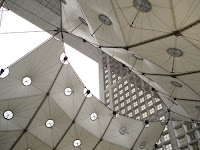
During Interim Term 2006, Prof. Norval Bard, French, and Prof. Sally Fowler, Philosophy, led a group of 20 from North Central College on a French adventure. The group met twice during Fall Term 2006 to get a head start on the course readings and materials as well as to receive background on international travel topics such as packing, electrical adaptors, GSM cell phones, basic French phrases and other helpful information. This blog is the report of our two week Interim 2006 adventure:
 GLS 177 was designed by Bard and Fowler for us to experience the History of France by traveling through it!. So we began in Avignon to visit and learn about Roman and Medieval France. Dr. Bard was the resource person for our stay in Avignon. In addition to Avignon we visited Arles, Nimes and Pont du Gard.
GLS 177 was designed by Bard and Fowler for us to experience the History of France by traveling through it!. So we began in Avignon to visit and learn about Roman and Medieval France. Dr. Bard was the resource person for our stay in Avignon. In addition to Avignon we visited Arles, Nimes and Pont du Gard. 
Then on to the Loire valley and Tours to learn about the beautiful French Renaissance chateaus and their gardens. Here Drs Bard & Fowler shared responsibility for the course materials and site visits. We visited Blois, Chenonceau and Angers.
 Finally to Paris to focus on the 17th century forward -- although we did spend some time with Medieval Paris. Again Drs Bard & Fowler shared responsibility, with the assistance of Dr. Fowler's friend and Paris guide, Michael Osman.
Finally to Paris to focus on the 17th century forward -- although we did spend some time with Medieval Paris. Again Drs Bard & Fowler shared responsibility, with the assistance of Dr. Fowler's friend and Paris guide, Michael Osman.We stayed in simple, but well-located two star hotels in Avignon, Tours and Paris, and traveled via regular train and bus services. All transportation within France as well as all site admissions fees were included in the program fee for the trip.
Planning has begun for the 2007 trip.
So please enjoy our 2006 journey and consider joining us on the next one!













































